Uncovering Stakeholders’ Participation to Better Understand Land Use Change Using Multi-Agent Modeling Approach: An Example of the Coal Mining Area of Shanxi, China
Abstract
:1. Introduction
2. Data and Methods
2.1. Research Area
2.2. Data Sources and Processing
2.3. Multi-Agent Modeling
2.3.1. Multi-Agent Simulation Structure
2.3.2. Multi-Agent Land Use Decision-Making Mechanism
- (1)
- Farmer module
- (2)
- Enterprise module
- (3)
- Scenario module
2.3.3. Model Implementation and Statistical Tests
3. Results and Analysis
3.1. The Attitude towards Land Requisition of Farmers with Different Livelihood Types
3.2. The Land Use Change Arising from Stakeholders’ Decision-Making Behavior
3.3. Construction and Accuracy Verification of the Multi-Agent Model
3.4. Future Land Use Pattern under Different Simulation Scenarios
4. Discussion
5. Conclusions
- (1)
- The trajectory of the land-use behavior of stakeholders in the study area show phased changes, which aroused significant changes in the land-use pattern of mining areas. The farmers’ attitude towards land use changes with their livelihood capital composition. Among them, labor capacity, cultivated land area, cultivated land quality, per capita annual income of families, and the importance of land requisition subsidies are considered to be important factors affecting farmers’ attitudes towards land requisition, which lead to certain land use decision-making behaviors.
- (2)
- The LUCC model based on a multi-agent framework was established using Netlogo software. Combined with the behavior decision rules of the stakeholders, the regional land-use change in 2019 was simulated. The overall fitting accuracy of the model was 76.31%, and the overall accuracy of the kappa coefficient test was 0.83, which demonstrates that the established model has certain credibility and accuracy for simulating the change in land use patterns of Yuanji Village.
- (3)
- Three scenarios were designed to predict the trajectory of land-use change in 2026. The trend scenario presents the most likely land use pattern of the village in the future natural development state. The economic development scenario shows that industrial and mining land occupy other land types over a large area and become the mainland type. The land-use pattern under the ecological protection scenario was the most suitable. The areas of cultivated land, forest land, and grassland will expand with landscape restoration and vegetation reconstruction.
Author Contributions
Funding
Data Availability Statement
Conflicts of Interest
References
- Berkel, D.; Verburg, P.H. Combining exploratory scenarios and participatory backcasting: Using an agent-based model in participatory policy design for a multi-functional landscape. Landsc. Ecol. 2012, 27, 641–658. [Google Scholar] [CrossRef] [PubMed] [Green Version]
- Reulier, R.; Delahaye, D.; Viel, V. Agricultural landscape evolution and structural connectivity to the river for matter flux, a multi-agents simulation approach. Catena 2018, 174, 524–535. [Google Scholar] [CrossRef]
- China’s State Council Information Office. White Paper: Energy in China’s New Era. [R/OL]. Available online: http://www.scio.gov.cn/ztk/dtzt/42313/44537/index.htm (accessed on 25 November 2022).
- Lin, J.; Fridley, D.; Lu, H.; Price, L.; Zhou, N. Has coal use peaked in China: Near-term trends in China’s coal consumption. Energy Policy 2018, 123, 208–214. [Google Scholar] [CrossRef]
- Sun, Z.; Wang, W.; Zhu, W.; Ma, L.; Dong, Y.; Lu, J. Evolutionary game analysis of coal enterprise resource integration under government regulation. Environ. Sci. Pollut. Res. 2021, 29, 7127–7152. [Google Scholar] [CrossRef]
- Li, B.; Haneklaus, N. The role of clean energy, fossil fuel consumption and trade openness for carbon neutrality in China. Energy Rep. 2022, 8, 1090–1098. [Google Scholar] [CrossRef]
- Li, L.; Lei, Y.; Wu, S.; He, C.; Yan, D. Study on the coordinated development of economy, environment and resource in coal-based areas in Shanxi Province in China: Based on the multi-objective optimization model. Resour. Policy 2018, 55, 80–86. [Google Scholar] [CrossRef]
- Cao, X. Policy and regulatory responses to coalmine closure and coal resources consolidation for sustainability in Shanxi, China. J. Clean. Prod. 2017, 145, 199–208. [Google Scholar] [CrossRef]
- Bakker, M.M.; Alam, S.J.; Dijk, J.V.; Rounsevell, M. Land-use change arising from rural land exchange: An agent-based simulation model. Landsc. Ecol. 2015, 30, 273–286. [Google Scholar] [CrossRef] [Green Version]
- Wu, Y.; Hui, E.C.M.; Zhao, P.; Long, H. Land use policy for urbanization in China. Habitat Int. 2018, 77, 40–42. [Google Scholar] [CrossRef]
- Wang, J.; Lin, Y.; Glendinning, A.; Xu, Y. Land-use changes and land policies evolution in China’s urbanization processes. Land Use Policy 2018, 75, 375–387. [Google Scholar] [CrossRef]
- Liu, P.; Rayenscroft, N. Collective action in implementing top-down land policy: The case of Chengdu, China. Land Use Policy 2017, 65, 45–52. [Google Scholar] [CrossRef]
- Brady, M.; Sahrbacher, C.; Kellermann, K.; Happe, K. An agent-based approach to modeling impacts of agricultural policy on land use, biodiversity and ecosystem services. Landsc. Ecol. 2012, 27, 1363–1381. [Google Scholar] [CrossRef]
- Buya, S.; Tongkumchum, P.; Owusu, B. Modelling of land-use change in Thailand using binary logistic regression and multinomial logistic regression. Arab. J. Geosci. 2020, 13, 437. [Google Scholar] [CrossRef]
- Aburas, M.; Ahamad, M.S.S.; Omar, N. Spatio-temporal simulation and prediction of land-use change using conventional and machine learning models: A review. Environ. Monit. Assess. 2019, 191, 205. [Google Scholar] [CrossRef]
- Sun, B.; Robinson, D.T. Comparison of Statistical Approaches for Modelling Land-Use Change. Land 2019, 7, 144. [Google Scholar] [CrossRef] [Green Version]
- Cerrillo, R.M.N.; Rodriguez, G.P.; Rumbao, I.C.; Lara, M.A.; Bonet, F.J.; Mesas-Carrascosa, F.J. Modeling Major Rural Land-Use Changes Using the GIS-Based Cellular Automata Metronamica Model: The Case of Andalusia (Southern Spain). ISPRS Int. J. Geo-Inf. 2020, 9, 458. [Google Scholar] [CrossRef]
- Song, X.; Hansen, M.C.; Stehman, S.V.; Potapov, P.V.; Tyukavina, A.; Vermote, E.F.; Townshend, J.R. Global land change from 1982 to 2016. Nature 2018, 560. [Google Scholar] [CrossRef]
- Noszczyk, T. A review of approaches to land use changes modeling. Hum. Ecol. Risk Assess. 2019, 25, 1377–1405. [Google Scholar] [CrossRef]
- Mozgeris, G.; Jukneliene, D. Modeling Future Land Use Development: A Lithuanian Case. Land 2021, 10, 360. [Google Scholar] [CrossRef]
- Dai, E.; Ma, L.; Yang, W.; Wang, Y.; Tong, M. Agent-based model of land system: Theory, application and modelling framework. J. Geogr. Sci. 2020, 30, 1555–1570. [Google Scholar] [CrossRef]
- Ligtenberg, A.; Bregt, A.K.; Lammeren, R.V. Multi-actor-based land use modelling: Spatial planning using agents. Landsc. Urban Plan. 2001, 56, 21–33. [Google Scholar] [CrossRef]
- Deadman, P.; Robinson, D.; Moran, E.; Brondizio, E. Colonist Household Decisionmaking and Land-Use Change in the Amazon Rainforest: An Agent-Based Simulation. Environ. Plan. B Plan. Des. 2004, 31, 693–709. [Google Scholar] [CrossRef] [Green Version]
- Liu, X.; Xia, L.; Yeh, G.O. Multi-agent systems for simulating spatial decision behaviors and land-use dynamics. Chin. Sci. Earth Sci. 2006, 49, 1184–1194. [Google Scholar] [CrossRef]
- Yuan, M.; Liu, Y. Land use optimization allocation based on multi-agent genetic algorithm. Trans. Chin. Soc. Agric. Eng. 2014, 30, 191–199. [Google Scholar] [CrossRef]
- Evans, T.P.; Manire, A.; Castro, F.D.; Brondizio, E.; Mccracken, S. A dynamic model of household decision-making and parcel level landcover change in the eastern amazon. Ecol. Model. 2001, 143, 95–113. [Google Scholar] [CrossRef]
- Fontaine, C.M.; Rounsevell, M. An agent-based approach to model future residential pressure on a regional landscape. Landsc. Ecol. 2009, 24, 1237–1254. [Google Scholar] [CrossRef]
- Gan, J.; Langeveld, J.; Smith, C.T. An Agent-Based Modeling Approach for Determining Corn Stover Removal Rate and Transboundary Effects. Environ. Manag. 2014, 53, 333–342. [Google Scholar] [CrossRef]
- Le, Q.B.; Park, S.J.; Vlek, P.L.G.; Cremers, A.B. Land-use dynamic simulator (ludas): A multi-agent system model for simulating spatio-temporal dynamics of coupled human–landscape system. i. structure and theoretical specification. Ecol. Inform. 2008, 3, 135–153. [Google Scholar] [CrossRef]
- Macal, C.M.; North, M.J. Tutorial on agent-based modelling and simulation. J. Simul. 2010, 4, 151–162. [Google Scholar] [CrossRef]
- Valbuena, D.; Verburg, P.H.; Bregt, A.K.; Ligtenberg, A. An agent-based approach to model land-use change at a regional scale. Landsc. Ecol. 2010, 25, 185–199. [Google Scholar] [CrossRef]
- Wu, Z.; Zhou, L.; Wang, Y. Prediction of the Spatial Pattern of Carbon Emissions Based on Simulation of Land Use Change under Different Scenarios. Land 2022, 11, 1788. [Google Scholar] [CrossRef]
- Carbo, J.; Sanchez-Pi, N.; Molina, J.M. Agent-based simulation with NetLogo to evaluate ambient intelligence scenarios. J. Simul. 2018, 12, 42–52. [Google Scholar] [CrossRef]
- Bert, F.; North, M.; Rovere, S.; Tatara, E.; Macal, C.; Podesta, G. An agent based model to simulate structural and land use changes in agricultural systems of the argentine pampas. Ecol. Model. 2011, 222, 3486–3499. [Google Scholar] [CrossRef]
- Bijandi, M.; Karimi, M.; van der Knaap, W.; Bansouleh, B.F. A novel approach for multi-stakeholder agricultural land reallocation using agent-based modeling: A case study in iran. Landsc. Urban Plan. 2021, 215, 0169–2046. [Google Scholar] [CrossRef]
- Koch, J.; Dorning, M.A.; Berkel, D.V.; Beck, S.M.; Sanchez, G.M.; Shashidharan, A.; Smart, L.S.; Zhang, Q.; Smith, J.W.; Meentemeyer, R.K. Modeling landowner interactions and development patterns at the urban fringe. Landsc. Urban Plan. 2018, 182, 101–113. [Google Scholar] [CrossRef]
- White, S.S.; Selfa, T. Shifting Lands: Exploring Kansas Farmer Decision-Making in an Era of Climate Change and Biofuels Production. Environ. Manag. 2013, 51, 379–391. [Google Scholar] [CrossRef]
- Chang, H.; Ai, P.; Li, Y. Land tenure policy and off-farm employment in rural china. Iza J. Dev. Migr. 2018, 8, 9. [Google Scholar] [CrossRef] [Green Version]
- Cui, Y.; Zhang, H.; Hao, X.J.; Zhang, X.Y. Sustainable livelihood of farmers in Yangquan mining area of Shanxi Province. Acta Ecol. Sin. 2020, 40, 6821–6830. [Google Scholar]
- Wang, J.; Xin, L.; Wang, Y. How farmers’ non-agricultural employment affects rural land circulation in china? J. Geogr. Sci. 2020, 30, 378–400. [Google Scholar] [CrossRef]
- Wu, X.; Ding, J.; Lu, B.; Wan, Y.; Shi, L.; Wen, Q. Eco-Environmental Effects of Changes in Territorial Spatial Pattern and Their Driving Forces in Qinghai, China (1980–2020). Land 2022, 11, 1772. [Google Scholar] [CrossRef]
- Mitter, H.; Larcher, M.; Schoenhart, M.; Stoettinger, M.; Schmid, E. Exploring Farmers’ Climate Change Perceptions and Adaptation Intentions: Empirical Evidence from Austria. Environ. Manag. 2019, 63, 804–821. [Google Scholar] [CrossRef] [PubMed]
- Liang, P.; Yang, X. Landscape spatial patterns in the Maowusu (Mu Us) Sandy Land, northern China and their impact factors. Catena 2016, 145, 321–333. [Google Scholar] [CrossRef]
- Papa, C.; Nzokou, P.; Mbow, C. Farmer Livelihood Strategies and Attitudes in Response to Climate Change in Agroforestry Systems in Kedougou, Senegal. Environ. Manag. 2020, 66, 218–231. [Google Scholar] [CrossRef] [PubMed]

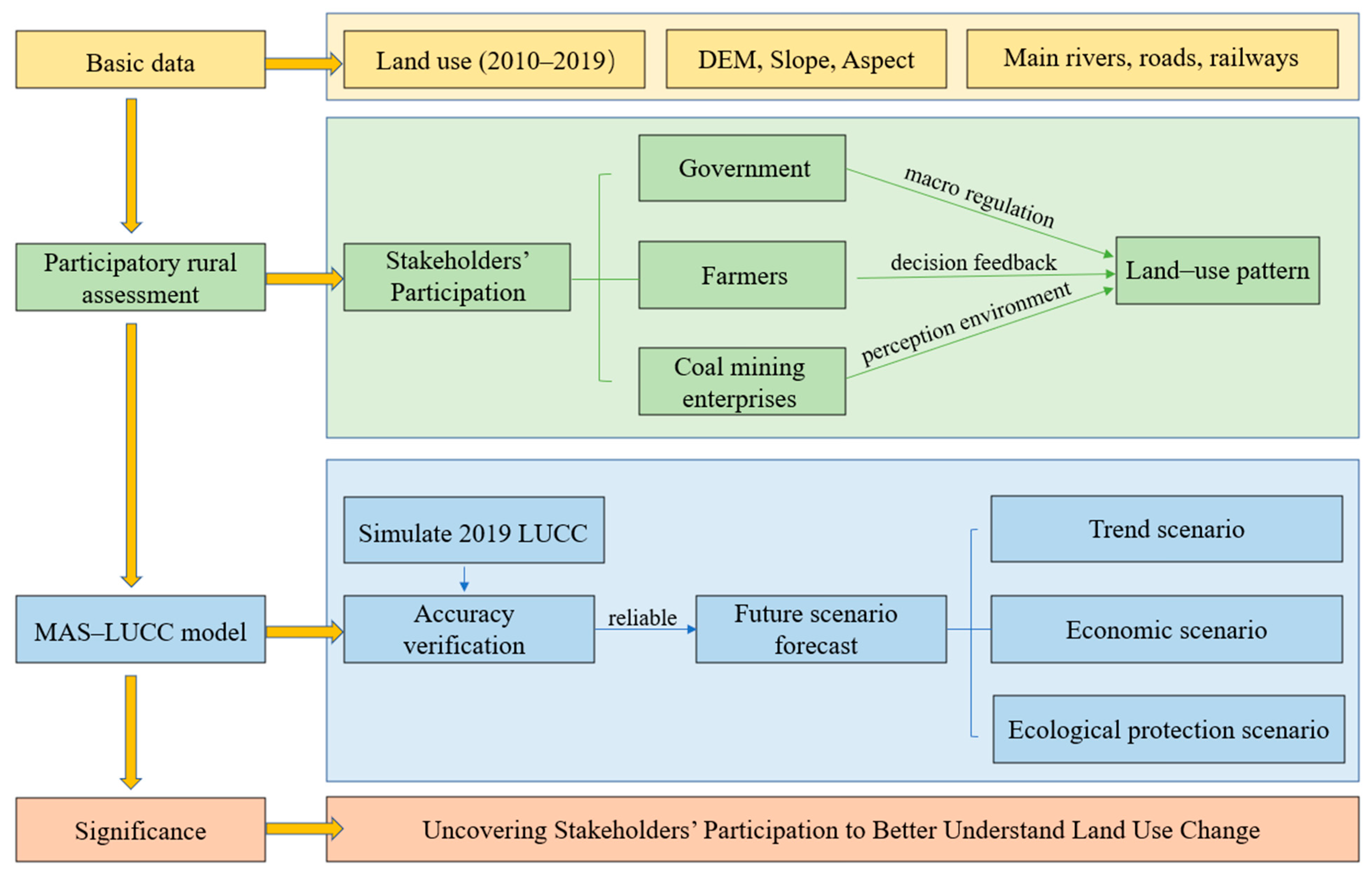
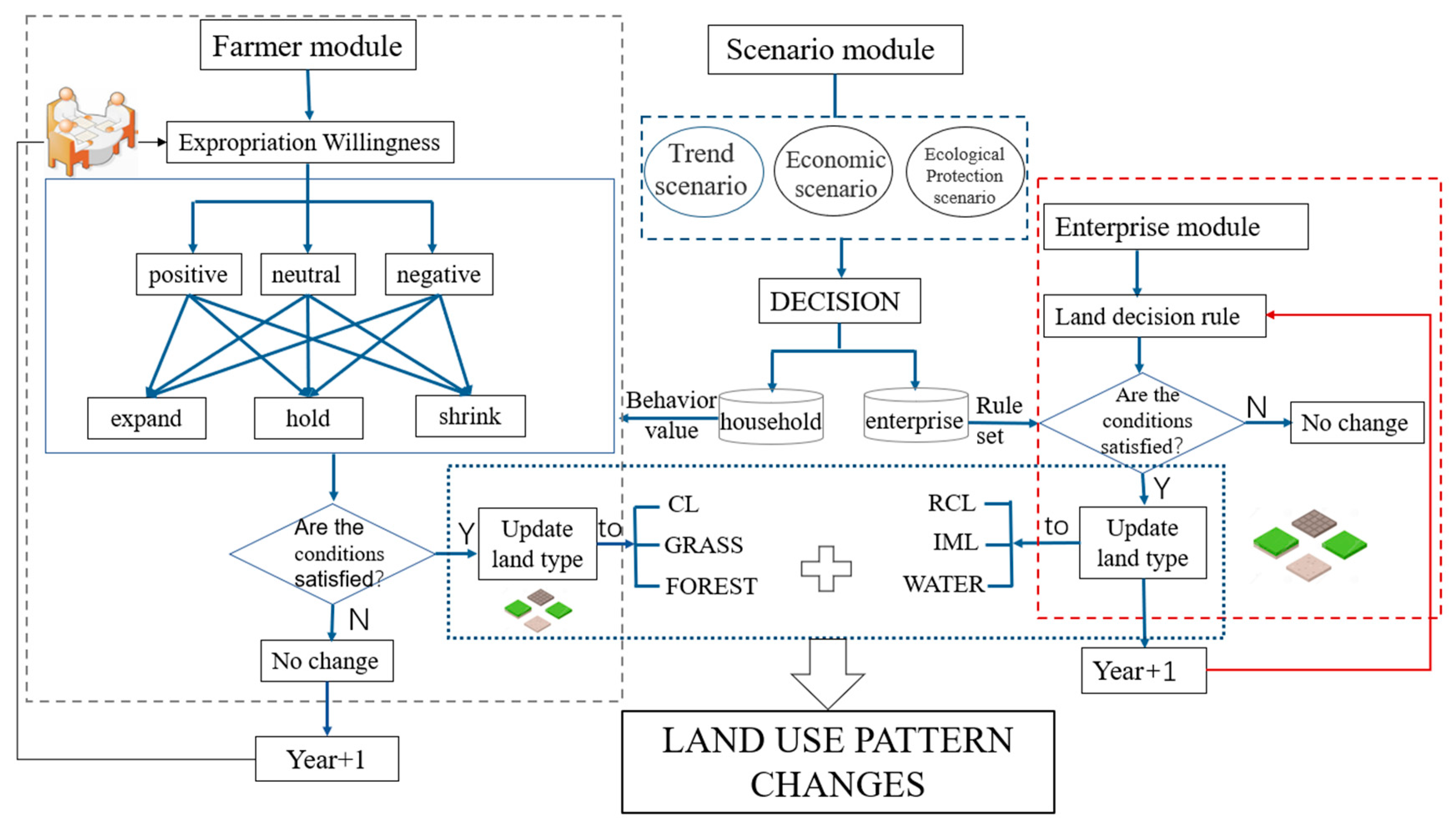
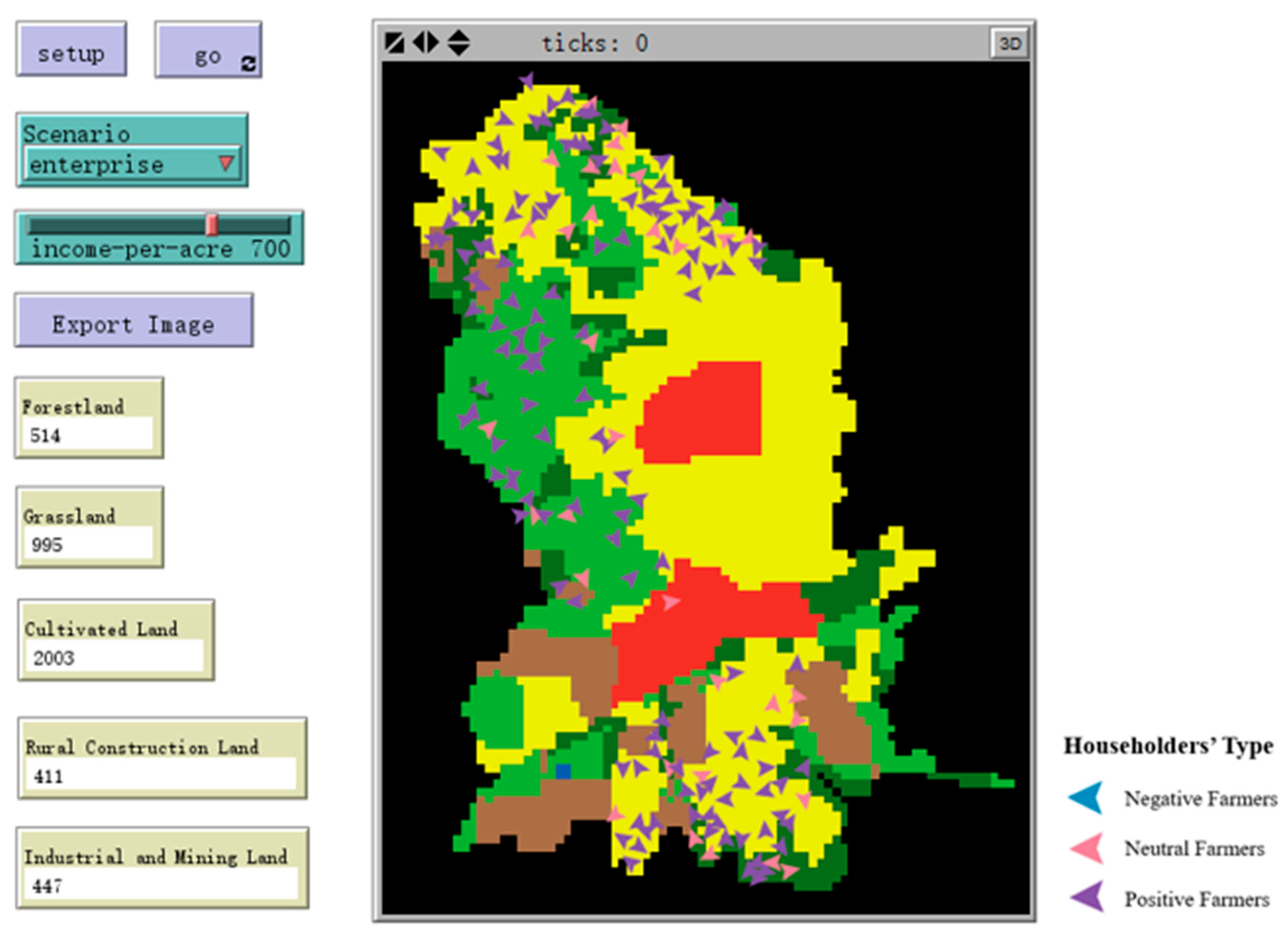
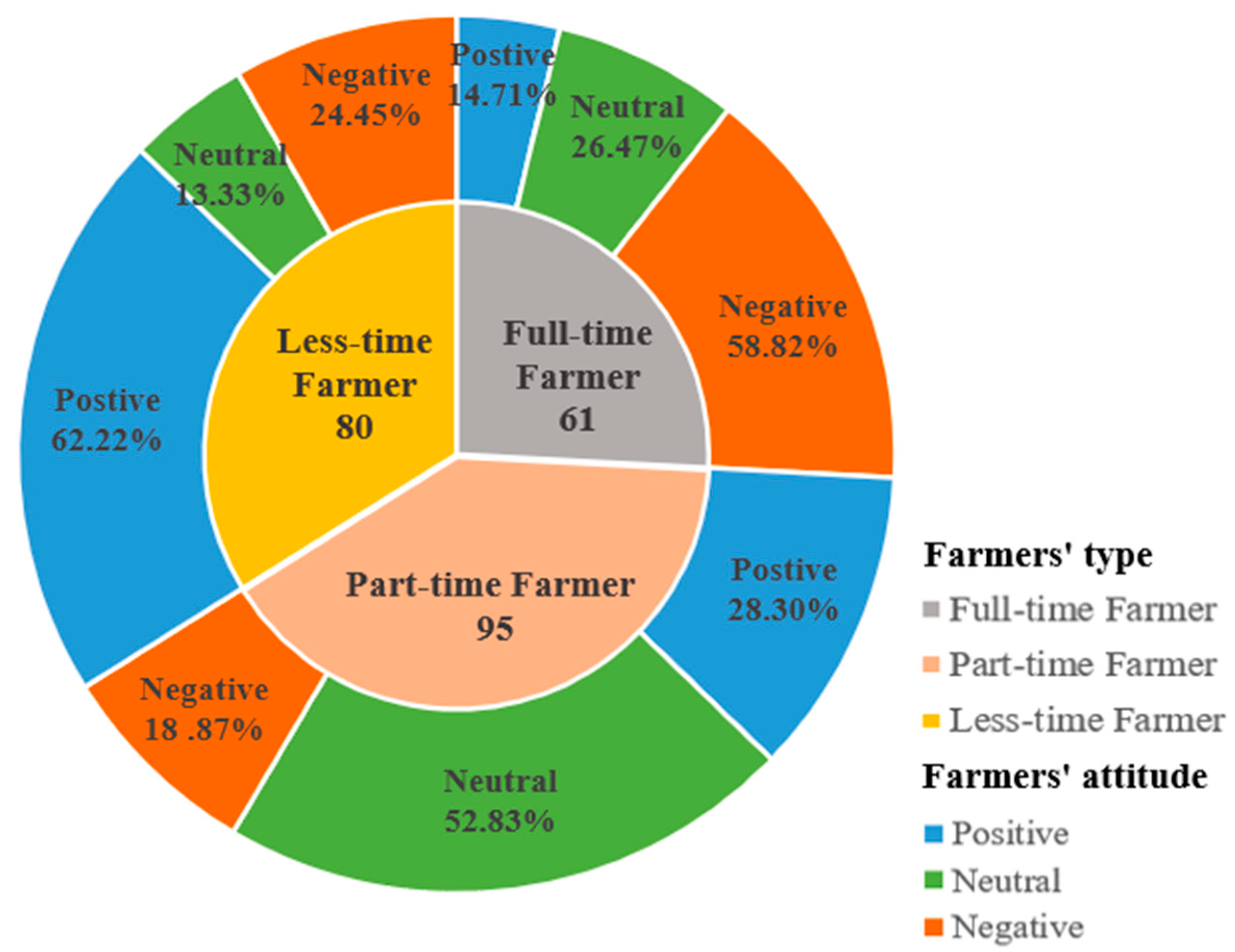
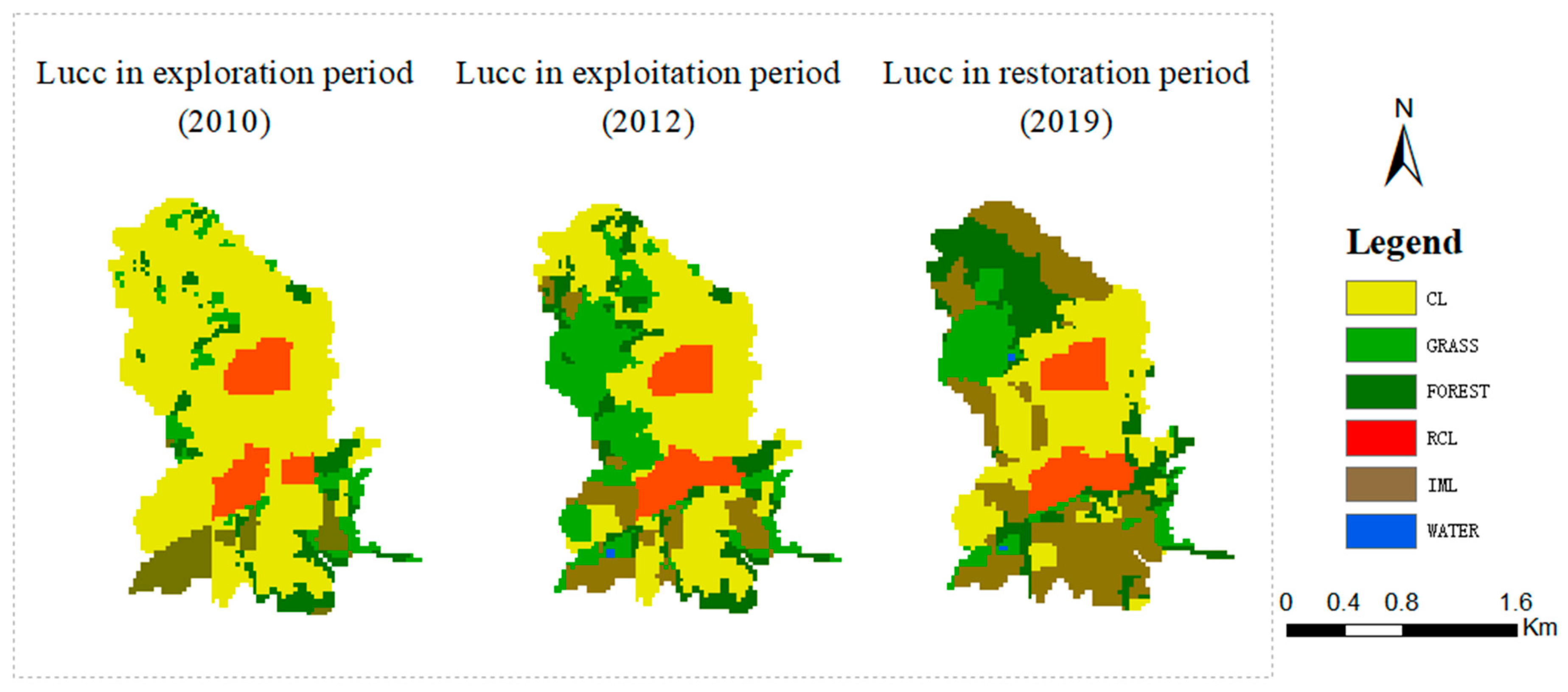



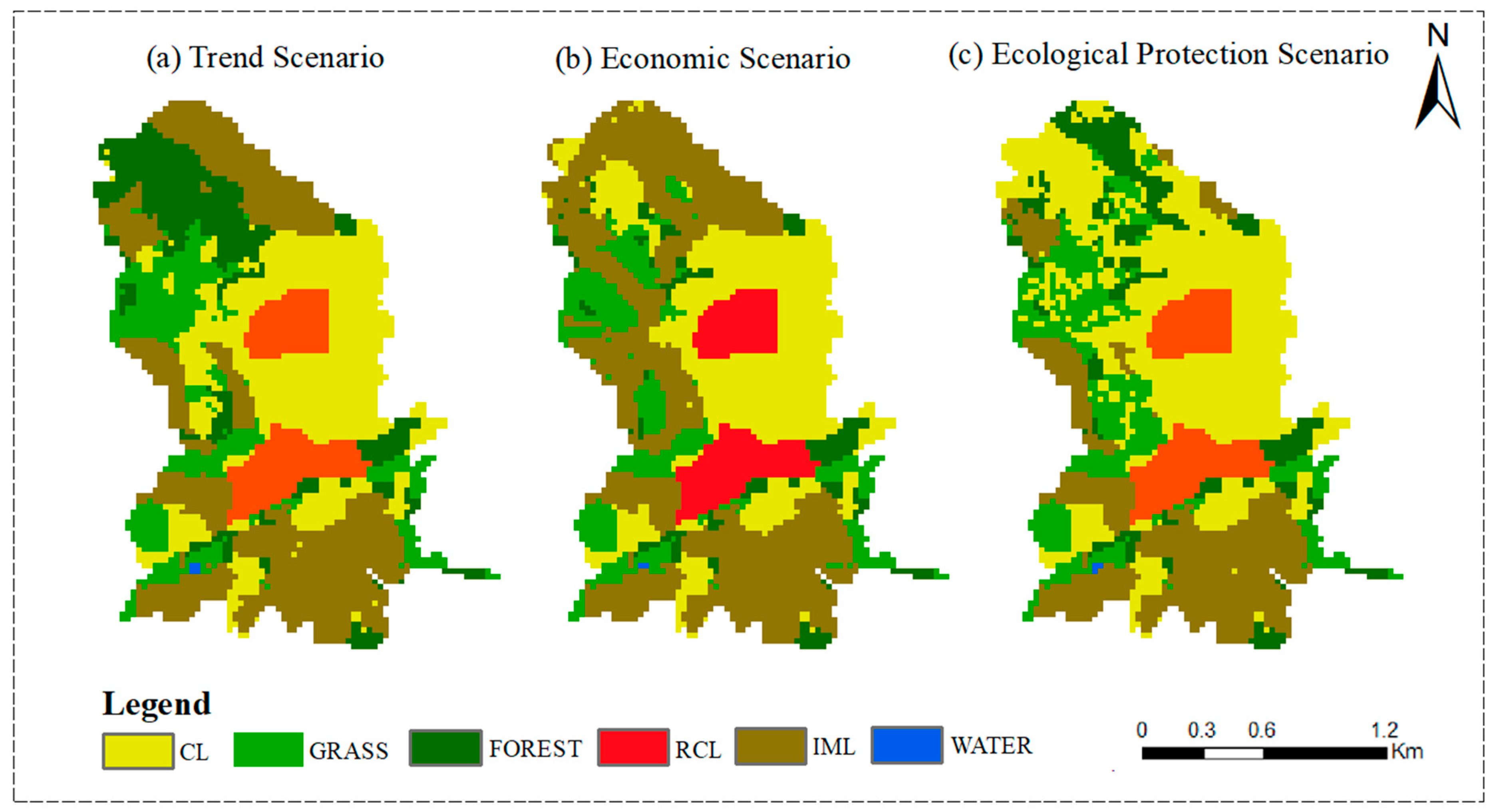

| Data Type | Data Content | Data Source |
|---|---|---|
| Land use data | Land use (2010–2019) | Remote sensing image interpretation (Landsat-8) |
| Environmental variables data | DEM, Slope, Aspect | http://www.gscloud.cn (accessed on 13 March 2022) |
| Main rivers, roads, railways | ||
| Agents’ attributes data | Government’s attributes information | Field investigation and interview |
| Farmers’ attributes information | ||
| Enterprises’ attributes information |
| Influence Factors | Estimation Results | Wald | df | p |
|---|---|---|---|---|
| Land area | −0.294 | 0.055 | 1 | 0.033 * |
| Land requisition subsidy | −11.631 | 21.275 | 1 | 0.014 * |
| Agricultural income | −5.908 | 13.386 | 1 | 0.008 ** |
| Health condition | −2.115 | 3.404 | 1 | 0.045 * |
| Age of farmer | −0.297 | 0.184 | 1 | 0.029 * |
| Cultivated land quality | 2.689 | 8.046 | 1 | 0.038 * |
| Fixed assets | −0.499 | 0.157 | 1 | 0.692 |
| Level of education | 4.220 | 1.652 | 1 | 0.199 |
| Neighborhood relations | 0.232 | 0.074 | 1 | 0.299 |
| Friend relief ability | 0.634 | 0.151 | 1 | 0.697 |
| Coal Mining Life Period | Land Use Decision of Stakeholders | Land Use Pattern | |
|---|---|---|---|
| Enterprise | Farmer Household | ||
| Exploration (before 2011) | - | Engaging in agricultural production. | Cultivated land was the main land use type. |
| Exploitation (2012—2017) | Large scale mining of mineral resources. | Began to develop sidelines, such as miners, industrial workers, and so on. | Industrial construction land has expanded, while cultivated land has shrunk. |
| Ecological restoration (after 2018) | Implement ecological restoration and develop modern agriculture and tourism. | Learn modern agricultural skills and broaden employment opportunities. | The area of forest land, grassland, and water area increased significantly. |
| Land Use Type | 2010 | 2012 | 2019 | |||
|---|---|---|---|---|---|---|
| Area (hm2) | Ratio (%) | Area (hm2) | Ratio (%) | Area (hm2) | Ratio (%) | |
| CL | 272.34 | 69.18 | 180.27 | 45.79 | 118.89 | 30.20 |
| GRASS | 25.02 | 6.36 | 89.55 | 22.75 | 44.91 | 11.41 |
| FOREST | 30.6 | 7.77 | 46.26 | 11.75 | 71.64 | 18.20 |
| RCL | 36.09 | 9.17 | 36.99 | 9.40 | 38.79 | 9.85 |
| IML | 29.61 | 7.52 | 40.23 | 10.22 | 118.89 | 30.20 |
| WATER | 0 | 0.00 | 0.36 | 0.09 | 0.54 | 0.14 |
| Overall | 393.66 | 100 | 393.66 | 100 | 393.66 | 100 |
| Land Use Type | CL | GRASS | FOREST | RCL | IML | WATER | Overall |
|---|---|---|---|---|---|---|---|
| Accuracy | 74.26% | 67.33% | 54.52% | 90.26% | 90.54% | 33.33% | 76.31% |
| Kappa | 0.70 | 0.56 | 0.56 | 0.92 | 0.88 | 0.40 | 0.83 |
Publisher’s Note: MDPI stays neutral with regard to jurisdictional claims in published maps and institutional affiliations. |
© 2022 by the authors. Licensee MDPI, Basel, Switzerland. This article is an open access article distributed under the terms and conditions of the Creative Commons Attribution (CC BY) license (https://creativecommons.org/licenses/by/4.0/).
Share and Cite
Guo, M.; Zhang, H.; Cui, Y.; Zhang, X.; Liu, Y. Uncovering Stakeholders’ Participation to Better Understand Land Use Change Using Multi-Agent Modeling Approach: An Example of the Coal Mining Area of Shanxi, China. Land 2022, 11, 2257. https://doi.org/10.3390/land11122257
Guo M, Zhang H, Cui Y, Zhang X, Liu Y. Uncovering Stakeholders’ Participation to Better Understand Land Use Change Using Multi-Agent Modeling Approach: An Example of the Coal Mining Area of Shanxi, China. Land. 2022; 11(12):2257. https://doi.org/10.3390/land11122257
Chicago/Turabian StyleGuo, Mengyuan, Hong Zhang, Yan Cui, Xiaoyu Zhang, and Yong Liu. 2022. "Uncovering Stakeholders’ Participation to Better Understand Land Use Change Using Multi-Agent Modeling Approach: An Example of the Coal Mining Area of Shanxi, China" Land 11, no. 12: 2257. https://doi.org/10.3390/land11122257




